Unbounce and Pagefly are two prominent platforms in the world of landing page creation and optimization. Both are designed to help businesses build high-converting landing pages without requiring advanced coding skills, but they cater to slightly different audiences and use cases.
Unbounce is often celebrated for its advanced features like A/B testing, AI-powered tools, and a robust selection of templates designed for marketers aiming to maximize conversions. On the other hand, Pagefly integrates seamlessly with Shopify, making it a go-to choice for eCommerce businesses seeking to optimize their product pages and improve their online store’s performance.
If you’re deciding between these two platforms, it can be challenging to pinpoint which is the best fit for your needs. In this guide, we’ll break down their features, pricing, templates, integrations, and more. By the end, you’ll have a clearer picture of which solution aligns with your goals and whether there’s an even better alternative out there.
Let’s dive in.
Unbounce vs Pagefly: Main Differences
When comparing Unbounce and Pagefly, it’s evident that each platform brings unique strengths to the table, catering to different types of users and goals. Below is a quick comparison of their core differences to help you understand what sets them apart:
| Feature | Unbounce | Pagefly |
|---|---|---|
| Primary Focus | Landing pages and conversion rate optimization | eCommerce-focused page building for Shopify stores |
| Ease of Use | Intuitive drag-and-drop builder, slightly steeper learning curve for beginners | Beginner-friendly, tailored for Shopify users |
| Templates | 100+ customizable templates optimized for various industries | 70+ templates focused on eCommerce needs |
| Integration Capabilities | Wide range of integrations (CRM, analytics, marketing tools, etc.) | Native Shopify integration and plugins, plus support for popular email and analytics tools |
| A/B Testing | Built-in A/B testing with AI-powered suggestions | Limited A/B testing (requires third-party tools or workarounds) |
| Customization | Highly flexible with support for custom HTML, CSS, and JS | Drag-and-drop design with limited custom code functionality |
| Pricing | Starts at $99/month | Free plan available, with premium plans starting at $24/month |
| Best For | Marketers, agencies, and businesses looking to optimize landing pages | Shopify store owners aiming to enhance product pages and boost conversions |
While both platforms allow users to create high-quality pages, Unbounce stands out for its focus on marketing and conversion rate optimization. Pagefly, on the other hand, excels in eCommerce, providing Shopify users with tools to improve their storefronts and product pages seamlessly.
How Do The Page Builders Compare?
Unbounce
Unbounce’s page builder features a user-friendly drag-and-drop interface that allows marketers to create and publish landing pages within minutes—no coding expertise required. This simplicity makes it an excellent choice for businesses seeking to optimize their marketing campaigns without relying on developers.

The platform offers section templates with pre-designed layouts across various categories like Lead Generation, Click-Through Pages, Event Signups, and more. These templates streamline the design process and ensure your pages are optimized for conversions from the start.
As for customization, Unbounce allows you to add widgets such as forms, buttons, videos, and custom HTML, CSS, or JavaScript. This flexibility gives users greater control over their page design compared to many competitors.
One of Unbounce’s standout features is its Smart Traffic tool. Powered by AI, Smart Traffic dynamically optimizes your landing page’s performance by directing visitors to the version most likely to convert based on their behavior. Additionally, Unbounce includes built-in A/B testing, enabling users to test different page versions and refine their campaigns.
However, there are a few drawbacks. The interface, while intuitive, may feel overwhelming for beginners who are new to landing page creation. Moreover, Unbounce lacks a dedicated mobile editor, so customizing designs specifically for mobile devices can be a bit cumbersome.
Unbounce also doesn’t include a website builder, focusing exclusively on landing pages. This might limit its appeal for users looking to create full websites rather than standalone landing pages.
Pagefly
Pagefly’s page builder is specifically designed for eCommerce businesses, particularly Shopify store owners, and provides a straightforward drag-and-drop experience tailored for creating product pages, landing pages, and homepages.
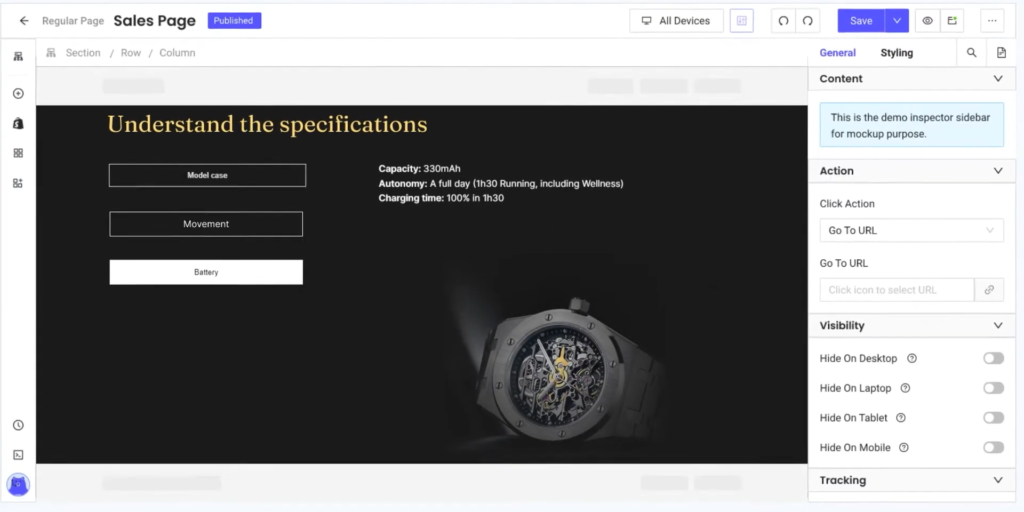
Unlike Unbounce, Pagefly’s builder is tightly integrated with Shopify, enabling seamless access to your store’s product catalog. This makes it easy to customize product descriptions, collections, and layouts directly within the builder. Additionally, Pagefly supports widgets such as countdown timers, image sliders, product reviews, and more—critical elements for boosting eCommerce conversions.
Pagefly offers templates specifically designed for online stores. These templates are categorized by use cases like product launches, seasonal promotions, and upselling strategies, making it easy for Shopify users to find designs that align with their goals.
One of Pagefly’s key strengths is its mobile editor, which allows users to create and adjust separate layouts for desktop, tablet, and mobile devices. This feature ensures your pages look polished across all screen sizes.
While Pagefly is beginner-friendly, it has some limitations in terms of customization for advanced users. It doesn’t natively support custom CSS, JavaScript, or advanced coding, which may restrict users seeking highly tailored designs.
Moreover, Pagefly doesn’t include features like Smart Traffic or native A/B testing tools. To conduct A/B tests, users must rely on third-party apps or external solutions. Additionally, Pagefly’s reliance on Shopify means it isn’t suitable for businesses that don’t operate within the Shopify ecosystem.
Both platforms excel in their respective domains, with Unbounce catering to marketers and Pagefly designed for eCommerce entrepreneurs.
Unbounce vs Pagefly: The Templates
Unbounce
Unbounce offers over 100 professionally designed templates optimized for various industries and purposes. These templates are categorized into use cases such as Lead Generation, Product Launches, Event Registration, and more. This variety makes it easy for users to find a starting point tailored to their goals.
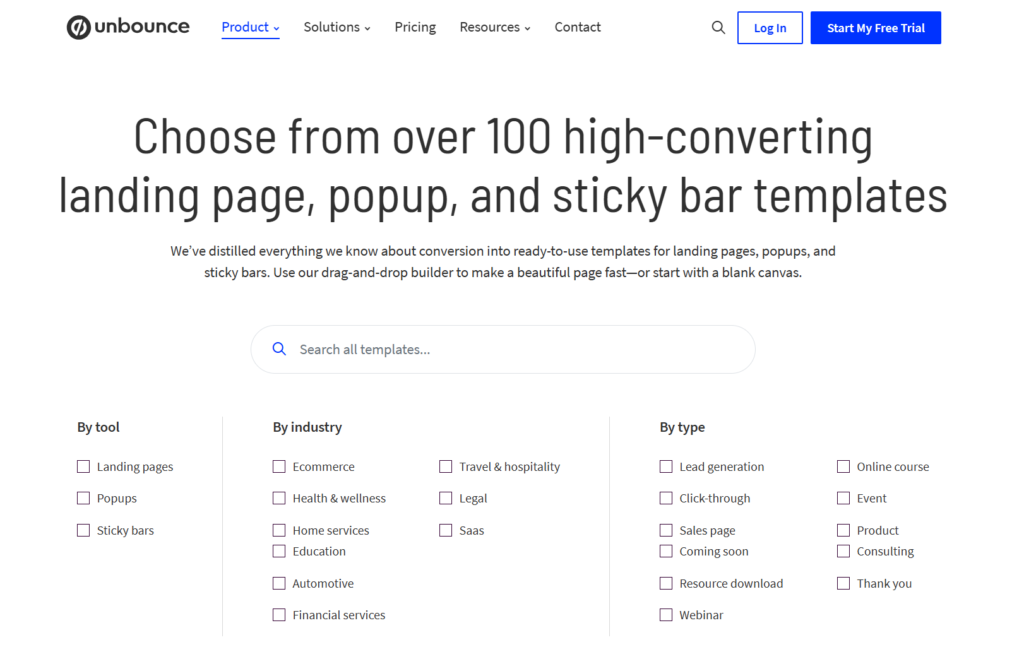
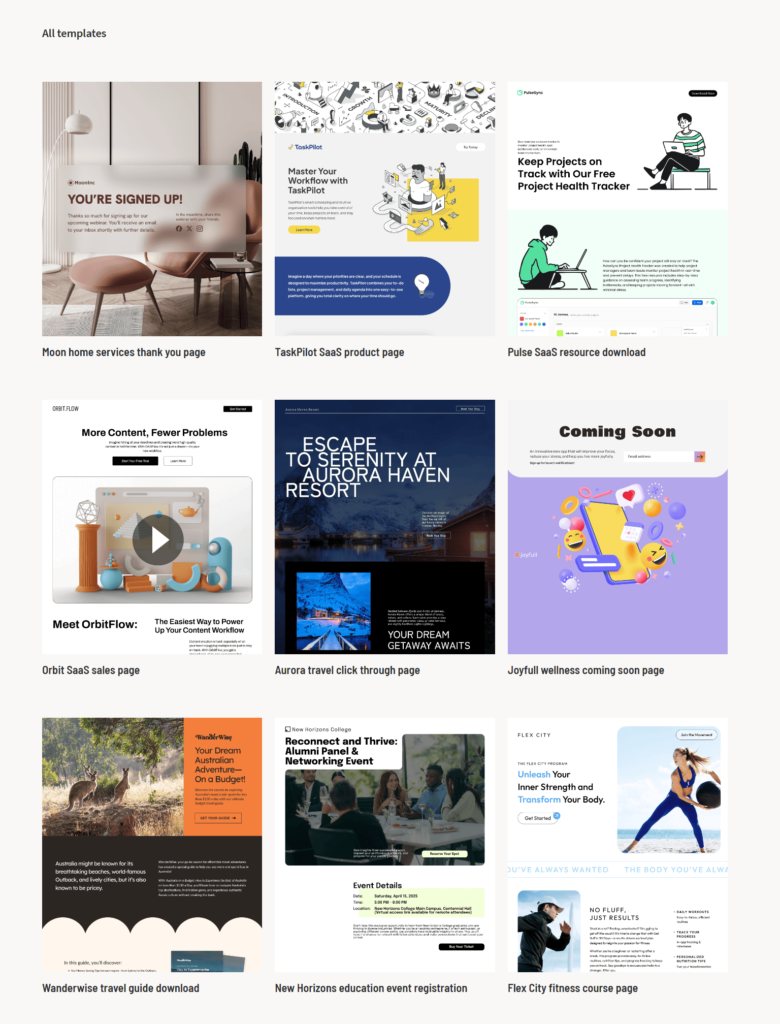
Each template is fully customizable using Unbounce’s drag-and-drop builder, allowing you to tweak the design to match your brand’s aesthetic. Templates are designed with conversion optimization in mind, ensuring that elements like CTAs, forms, and headings are strategically placed for maximum impact.
Additionally, Unbounce templates are responsive by default, meaning they automatically adapt to desktop, tablet, and mobile devices. However, while the responsiveness is effective, users cannot create separate layouts for each device, which may limit the level of mobile-specific design customization.
Unbounce also enables users to save their customized designs as reusable templates. This feature is particularly useful for businesses running multiple campaigns with similar layouts.
Pagefly
Pagefly provides over 70 templates specifically designed for eCommerce businesses. The templates cater to various eCommerce use cases, such as product pages, sales pages, landing pages, and collections.
These designs are tailored to the needs of Shopify store owners, ensuring they align well with online retail requirements.
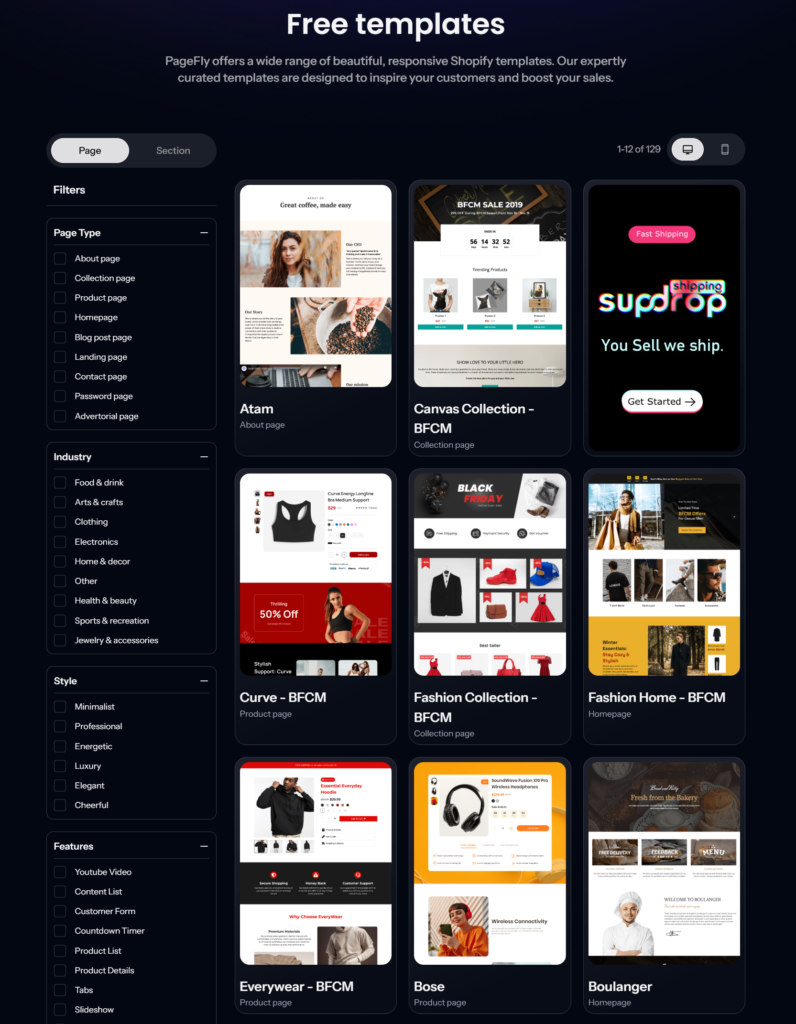
Unlike Unbounce, Pagefly templates are deeply integrated with Shopify, allowing users to directly pull product details, images, and pricing into their designs. This makes it easier to create visually appealing product pages without starting from scratch.
Pagefly’s templates are also fully responsive, and the platform allows users to customize layouts separately for desktop, tablet, and mobile devices. This feature ensures that your Shopify store pages are optimized for every screen size, giving Pagefly a significant advantage in mobile customization.
While Pagefly’s template library is smaller compared to Unbounce’s, its focus on eCommerce-specific layouts makes it a more specialized choice for online stores. Additionally, Pagefly’s drag-and-drop builder makes it simple to modify templates, although advanced customization options like adding custom CSS or JavaScript are limited.
Both platforms offer high-quality templates, but Unbounce’s library is broader and better suited for diverse industries, while Pagefly excels in providing Shopify-focused designs for eCommerce users.
Unbounce vs Pagefly: Building Pages At Scale
Unbounce
Unbounce is designed to help marketers and businesses build and manage landing pages efficiently, even at scale. One of its standout features for scaling is Dynamic Text Replacement (DTR), which allows you to personalize landing page content based on the keywords or parameters used in a visitor’s search query.
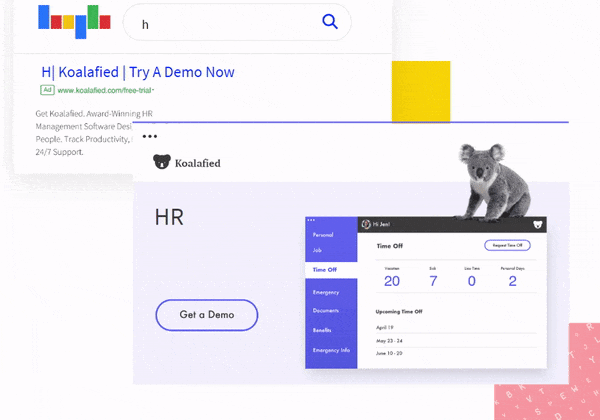
This capability is particularly useful for PPC campaigns, as it ensures your pages are tailored to specific audience segments without creating multiple versions manually.
For agencies or teams managing multiple campaigns, Unbounce includes features like sub-accounts and team collaboration tools. Sub-accounts allow you to organize campaigns under different client profiles or project categories, while collaboration tools enable team members to work on the same page, leave comments, and share feedback.
Additionally, Unbounce’s Smart Traffic feature uses AI to dynamically optimize landing page performance by directing traffic to the version most likely to convert. This eliminates the need for manual A/B testing and streamlines campaign optimization across multiple pages.
However, Unbounce lacks native integrations for managing multiple domains or accounts for large-scale eCommerce businesses, which could limit its effectiveness for users looking to operate extensive online storefronts.
Pagefly
Pagefly excels in helping Shopify store owners scale their eCommerce efforts. Since it’s directly integrated with Shopify, Pagefly makes it easy to manage multiple pages, including product pages, collection pages, and landing pages, all within the Shopify ecosystem.
Pagefly offers template duplication, allowing users to quickly replicate high-performing page designs for new products or campaigns. This feature is particularly useful for businesses managing large catalogs or seasonal promotions.
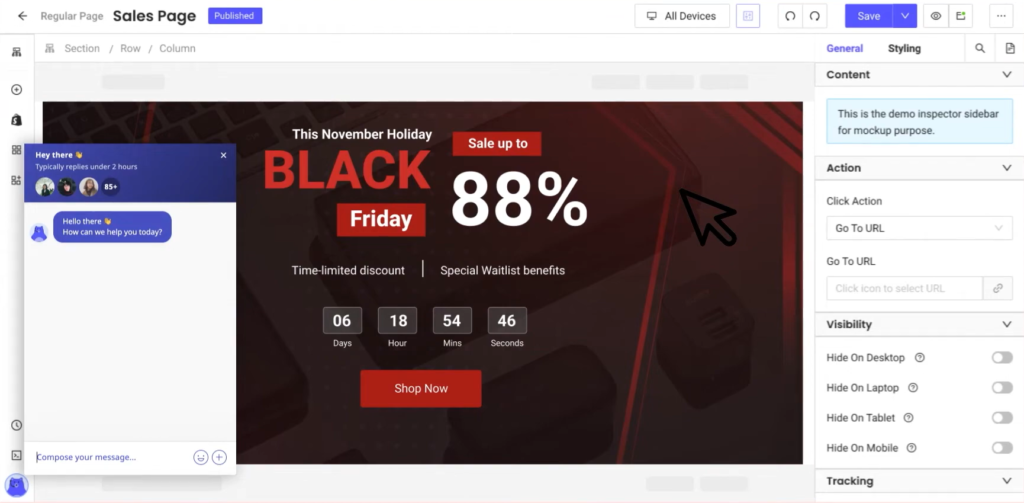
Additionally, Pagefly supports team collaboration through role-based permissions, which allow different team members (e.g., designers, marketers) to contribute to the page-building process. While not as robust as Unbounce’s sub-account system, these permissions help keep workflows organized within a single Shopify store.
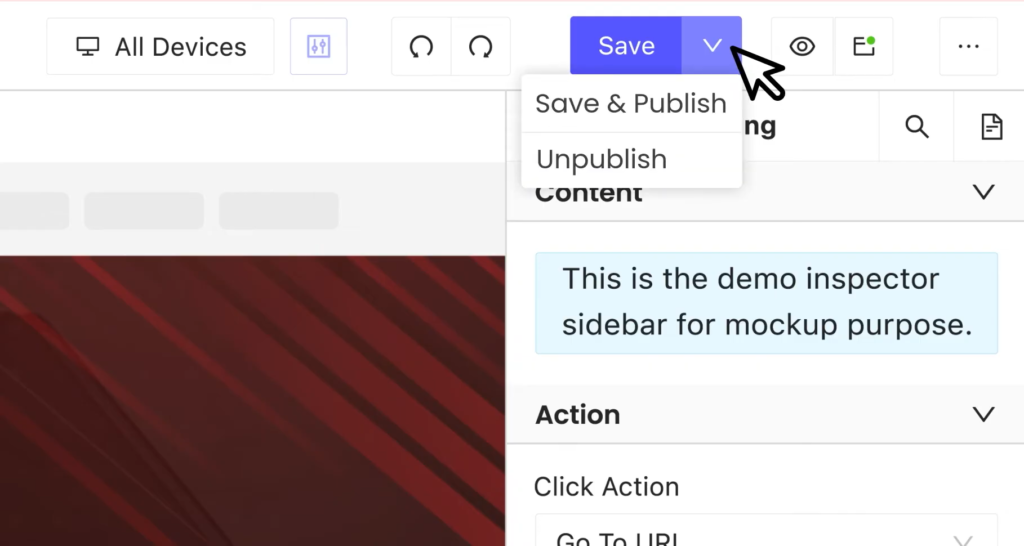
Pagefly’s mobile-first approach also makes it easier to scale by ensuring pages are optimized for mobile shoppers, who often make up the majority of eCommerce traffic. You can create separate layouts for desktop, tablet, and mobile devices, ensuring a seamless experience across all touchpoints.
However, Pagefly does not include advanced automation tools like Smart Traffic or DTR, which may limit its ability to streamline scaling for non-Shopify users or advanced marketing campaigns.
When it comes to building pages at scale, Unbounce offers tools that cater to marketers and agencies managing diverse campaigns, while Pagefly focuses on simplifying the process for Shopify users managing extensive eCommerce operations. Both platforms excel in their respective domains, making the right choice dependent on your specific scaling needs.
Unbounce vs Pagefly: Integrations
Unbounce
Unbounce integrates with a wide range of third-party tools, making it a versatile choice for marketers and businesses looking to streamline their workflows. The platform supports over 120 integrations, covering key categories like email marketing, CRM, analytics, and advertising.
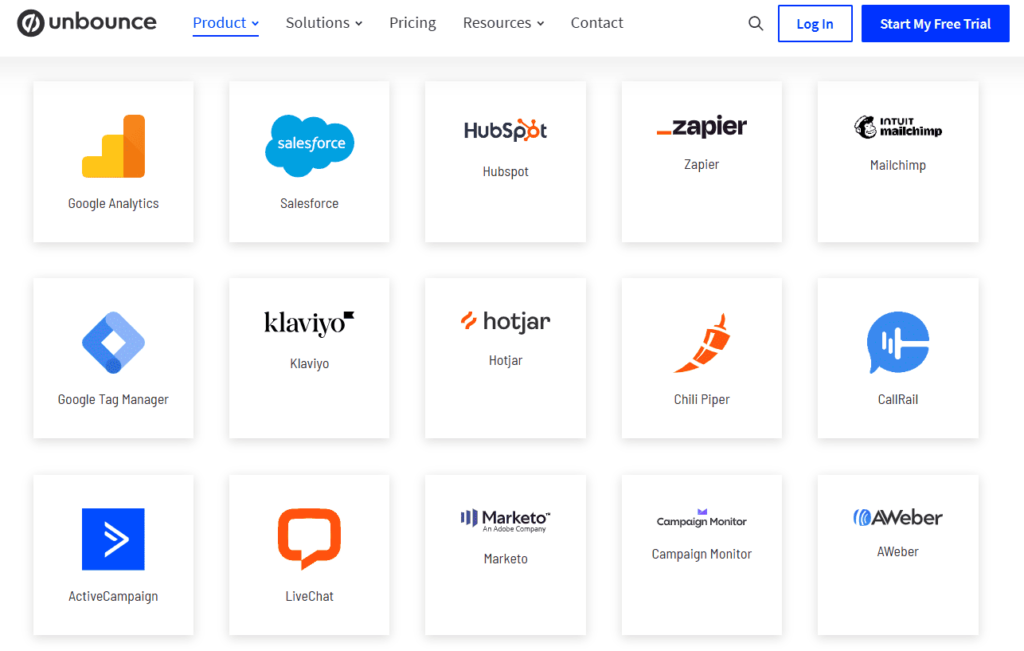
Popular integrations include:
- Email Marketing: Mailchimp, ActiveCampaign, Constant Contact
- CRM: Salesforce, HubSpot, Zoho CRM
- Analytics and Advertising: Google Analytics, Facebook Ads, Google Ads
- Automation: Zapier for connecting with thousands of additional tools
Unbounce also includes native integration with Dynamic Text Replacement (DTR), which allows marketers to link their pages with Google Ads campaigns seamlessly. This ensures that landing pages dynamically match a visitor’s search terms, improving ad relevance and conversion rates.
For more advanced use cases, Unbounce supports custom HTML, CSS, and JavaScript, enabling users to add specialized functionality or connect with unique tools not natively supported by the platform.
While Unbounce covers most essential tools for marketers, its integration ecosystem is not specifically tailored to eCommerce platforms like Shopify. Businesses looking for deeply embedded eCommerce features may need to rely on workarounds or external tools.
Pagefly
Pagefly’s integrations are heavily focused on enhancing eCommerce experiences, particularly within the Shopify ecosystem. As a Shopify app, Pagefly seamlessly connects with Shopify’s core features, allowing users to manage product catalogs, collections, and storefronts directly from the Pagefly editor.
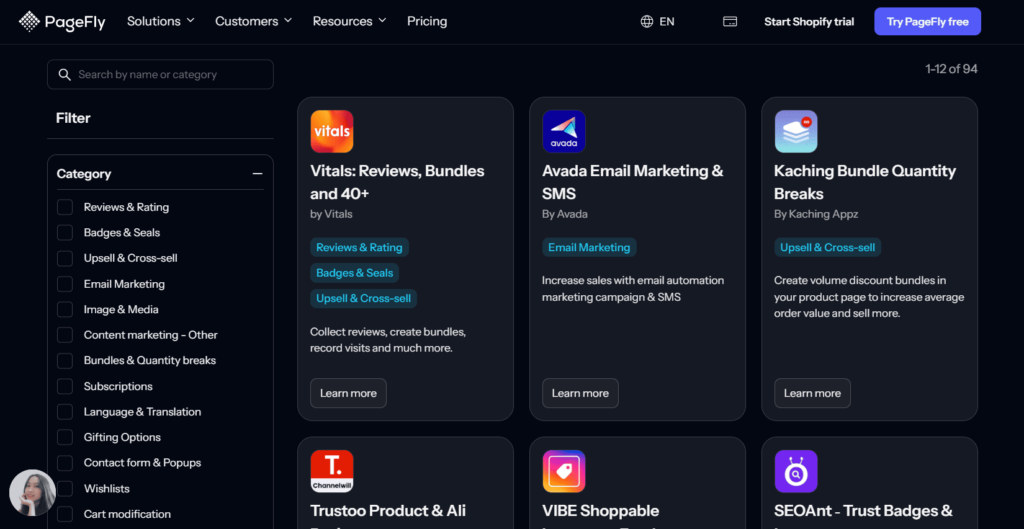
Beyond Shopify, Pagefly supports a variety of integrations that are crucial for online stores:
- Email Marketing: Klaviyo, Omnisend, Mailchimp
- Analytics: Google Analytics, Facebook Pixel
- Reviews and UGC: Loox, Judge.me, Ali Reviews
- Conversion Tools: Shopify apps like ReConvert and Tidio Live Chat
One of Pagefly’s standout integration features is its ability to work seamlessly with Shopify plugins and apps. This means users can enhance their pages with product review widgets, upsell pop-ups, and live chat functionalities, ensuring a highly customized shopping experience.
Pagefly also integrates with Zapier, enabling connections with other non-Shopify tools for additional flexibility. However, it does not support advanced marketing tools like Dynamic Text Replacement, nor does it have as extensive a library of integrations as Unbounce.
In summary, Unbounce is ideal for marketers seeking broad compatibility with CRM, advertising, and automation tools, while Pagefly focuses on providing deep Shopify integration and essential eCommerce-specific plugins. Your choice will depend on whether you prioritize marketing versatility or eCommerce optimization.
Unbounce vs Pagefly: Pricing
Unbounce
Unbounce offers four pricing plans tailored to businesses and agencies with varying needs. The pricing is as follows:
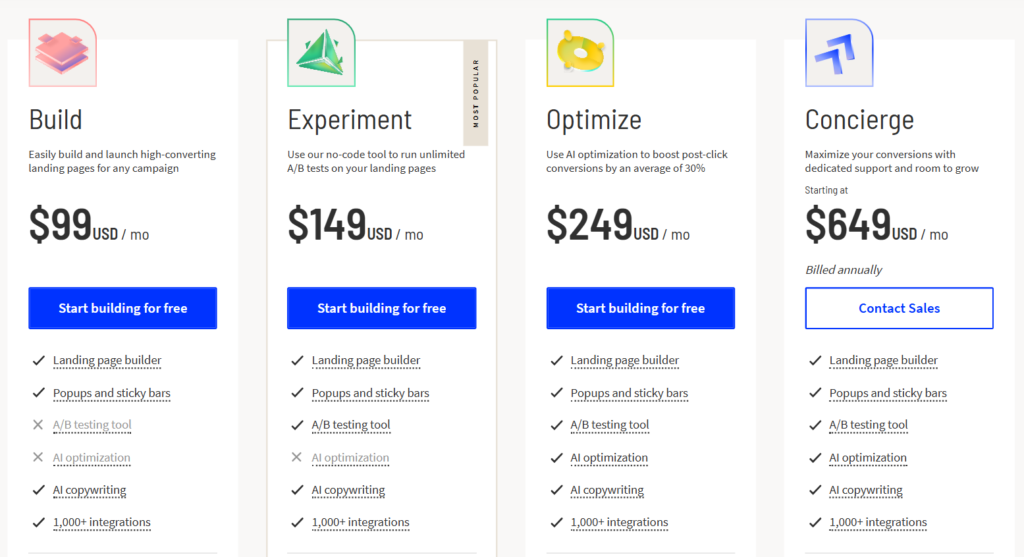
- Build: $99/month (monthly)
Includes unlimited landing pages, 1 user, 1 root domain, drag-and-drop builder, AI copywriting, and over 100 high-converting templates. Traffic volume supports up to 20k visitors per month. - Experiment: $149/month (monthly)
Adds unlimited A/B testing, 3 users, 2 root domains, dynamic text replacement, and conversion insights. Traffic volume supports up to 30k visitors per month. - Optimize: $249/month (monthly)
Includes AI traffic optimization, 5 users, 3 root domains, advanced triggers, targeting, and audience insights. Traffic volume supports up to 50k visitors per month. - Agency: Starts at $499/month (billed annually)
Designed for agencies, it supports unlimited collaborations, 20+ root domains, advanced industry benchmarking, and access to implementation services.
Unbounce also offers a 25% discount for annual billing, making it a cost-effective choice for long-term users.
Pagefly
Pagefly provides three pricing options, focusing on flexibility for Shopify store owners:
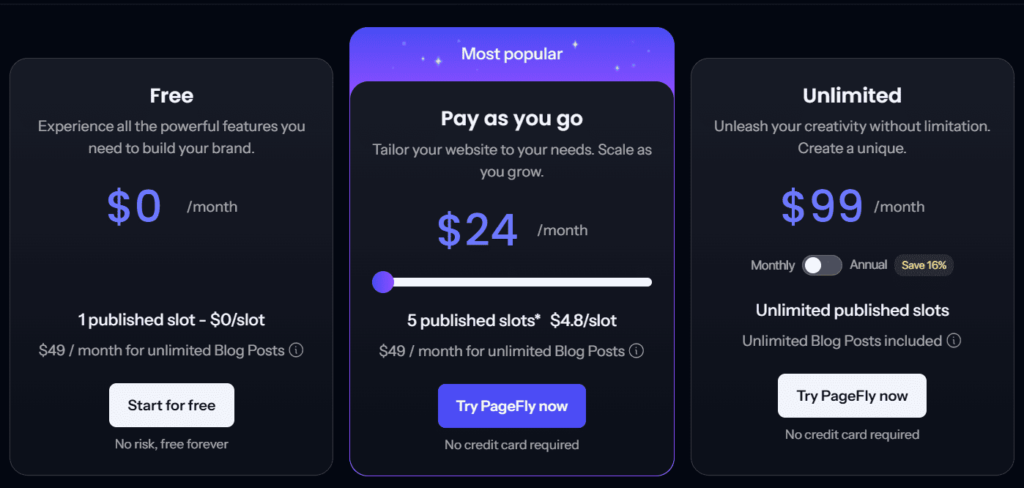
- Free Plan: $0/month
Includes 1 published slot, basic design tools, and access to Pagefly’s essential features. It’s ideal for users starting out. - Pay as You Go: $24/month
Includes 5 published slots at $4.8/slot, scaling to $49/month for unlimited blog posts. This plan is suitable for users looking to scale their store gradually. - Unlimited Plan: $99/month
Provides unlimited published slots and blog posts, allowing users to unleash their creativity without any restrictions. This plan is perfect for larger stores with extensive customization needs.
Pagefly’s pricing structure is straightforward and includes live chat support for all plans. Unlike Unbounce, it offers a free plan, making it more accessible for smaller businesses or those on a budget.
In summary, Unbounce caters to marketers with a focus on landing pages and conversion rate optimization, offering advanced features at higher price points. Pagefly, on the other hand, provides more budget-friendly options and specializes in eCommerce for Shopify users. Your choice will depend on whether you prioritize marketing tools or eCommerce functionality.
Unbounce vs Pagefly: Unique Features
Unbounce
Smart Traffic
Unbounce’s Smart Traffic feature is a standout tool powered by AI. It dynamically routes visitors to the most optimized landing page variation based on their behavior and attributes. This removes the need for manual A/B testing, saving marketers time while enhancing conversion rates. The tool learns and adapts over time, ensuring continuous optimization for better results.
Dynamic Text Replacement
Unbounce offers Dynamic Text Replacement (DTR), which allows marketers to tailor landing page content to match the search intent of visitors. By syncing with PPC campaigns, DTR ensures the text on your page reflects the keywords used in ads, increasing relevance and improving conversions.
Popups and Sticky Bars
With Unbounce, you can create popups and sticky bars to complement your landing pages. These tools help capture leads, promote offers, or drive specific actions. The editor is highly customizable, allowing you to add forms, buttons, and dynamic CTAs. Sticky bars can be placed at the top or bottom of the page for persistent visibility.
Conversion Insights
Unbounce provides Conversion Insights that analyze user behavior on your landing pages. It highlights areas for improvement, such as form optimization or call-to-action placement, to maximize engagement and conversions.
Pagefly
Shopify integration
One of Pagefly’s most unique features is its deep integration with Shopify. Unlike Unbounce, Pagefly allows users to seamlessly connect with their Shopify store, enabling easy access to product catalogs and real-time updates for product pages. This integration ensures that all eCommerce tools within Shopify work harmoniously with Pagefly designs.
Customizable mobile layouts
Pagefly excels with its mobile-first approach. Users can customize desktop, tablet, and mobile layouts independently, ensuring an optimal viewing experience across all devices. This flexibility is particularly important for eCommerce, where mobile traffic often dominates.
Widgets and add-ons
Pagefly supports a wide range of widgets and add-ons, including countdown timers, product reviews, testimonials, and image sliders. These elements are critical for creating engaging product pages and enhancing the overall shopping experience. While Unbounce focuses on conversions, Pagefly’s features are tailored to building robust eCommerce storefronts.
Collaboration tools
Pagefly includes team collaboration features, allowing users to assign roles and permissions to team members. Designers, marketers, and developers can work together efficiently on product pages and landing pages, making it easier for Shopify teams to launch campaigns.
The Verdict
Unbounce is an excellent option for businesses focused on marketing and landing page optimization. Its Smart Traffic and Dynamic Text Replacement tools give it a distinct edge for conversion-focused campaigns. On the other hand, Pagefly is the go-to choice for Shopify store owners who need highly customizable product pages and deep Shopify integration.
Both platforms cater to specific audiences, making the choice clear based on your needs: go with Unbounce for advanced marketing features or choose Pagefly for robust eCommerce capabilities.
Instapage: The Better Alternative?
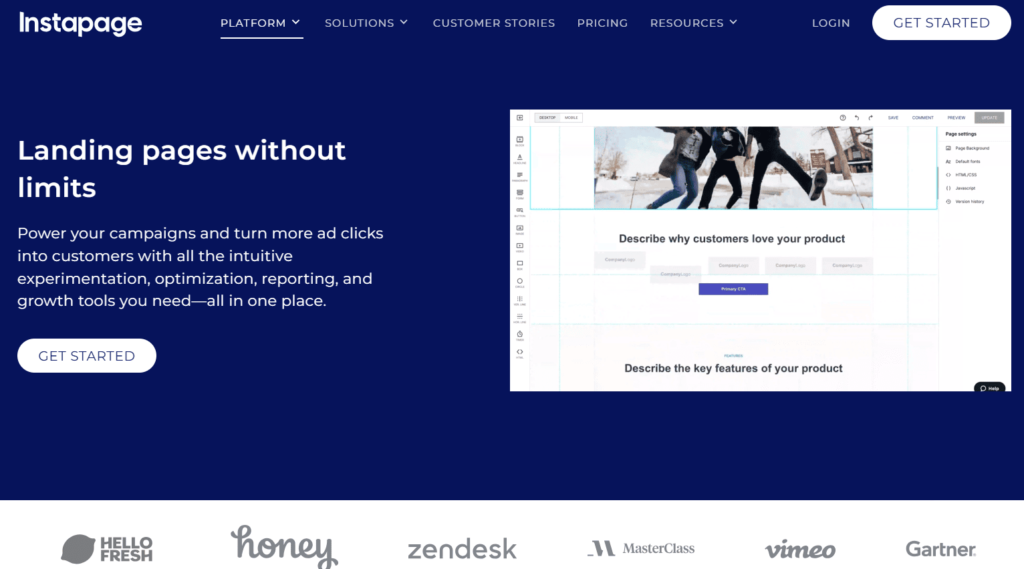
While both Unbounce and Pagefly excel in their respective domains—Unbounce as a conversion-focused landing page builder and Pagefly as a Shopify-centric page creation tool—neither platform might be the perfect fit for everyone.
This is where Instapage emerges as a strong contender, offering a balance of customization, collaboration, and performance optimization that appeals to marketers and businesses across industries.
Why Instapage?
Instapage is designed for teams and marketers looking to build personalized, high-converting landing pages at scale. Here’s what makes it a compelling alternative:
1. Advanced Customization
Instapage provides unparalleled flexibility with its drag-and-drop builder. Unlike many other platforms, you can place widgets and elements anywhere on the page without restrictions, giving you full creative control. Additionally, Instapage supports custom HTML, CSS, and JavaScript, allowing for even more tailored designs.
2. AMP Landing Pages
Instapage includes a dedicated AMP (Accelerated Mobile Pages) builder, which ensures your pages load quickly and perform exceptionally well on mobile devices. This feature is particularly valuable for businesses targeting mobile audiences where page speed is crucial for conversions.
3. Real-Time Collaboration
For teams, Instapage offers collaboration tools that make the design process seamless. Team members can leave comments, tag others, and make real-time edits directly on the platform. This level of integration streamlines workflows and reduces the need for external project management tools.
4. Conversion Optimization
Instapage is equipped with heatmaps and advanced analytics, providing insights into user behavior on your pages. Combined with its A/B testing tools and AdMap functionality, which visually links ad campaigns to landing pages, Instapage ensures that you can continuously refine your marketing efforts for better results.
5. Global Blocks
The Global Blocks feature allows you to save specific page elements (like headers, footers, or CTAs) and reuse them across multiple pages. Any updates to a Global Block are applied universally, saving time and maintaining consistency across campaigns.
Is Instapage Right for You?
Instapage’s feature set positions it as a premium solution, particularly for marketers and teams focused on large-scale campaigns. However, its pricing is significantly higher than both Unbounce and Pagefly, which might be a deciding factor for budget-conscious users.
If your primary goal is optimizing landing pages for maximum conversions with advanced tools and collaboration features, Instapage might be the best alternative. But for eCommerce businesses or those seeking a more budget-friendly option, Pagefly or Unbounce might still be better fits.
Ultimately, the right platform depends on your specific needs, whether it’s landing page versatility, eCommerce optimization, or marketing-focused scalability.
Frequently Asked Questions
What is Unbounce best suited for?
Unbounce is ideal for marketers and businesses that want to create high-converting landing pages without coding skills. Its advanced tools, such as Smart Traffic and Dynamic Text Replacement, make it perfect for running PPC campaigns and optimizing conversions.
Who should use Pagefly?
Pagefly is best suited for Shopify store owners who want to design and customize product pages, collections, and landing pages. Its deep integration with Shopify makes it the go-to choice for eCommerce businesses.
Does Unbounce support eCommerce?
While Unbounce can be used to create landing pages for eCommerce campaigns, it is not specifically designed for Shopify or other eCommerce platforms. Pagefly, with its Shopify integration, is a better choice for eCommerce-focused businesses.
Can Pagefly be used outside of Shopify?
No, Pagefly is built exclusively for Shopify users. If you’re looking for a platform that works independently of Shopify, Unbounce or Instapage might be better alternatives.
Which platform offers better value for money?
The answer depends on your specific needs. Pagefly offers a free plan and affordable pricing, making it budget-friendly for eCommerce users. Unbounce, while more expensive, provides advanced marketing tools and features, offering greater value for businesses focused on conversions and lead generation.
Read more related article:
Unbounce coupon code: Get Upto 35% discount for the first year